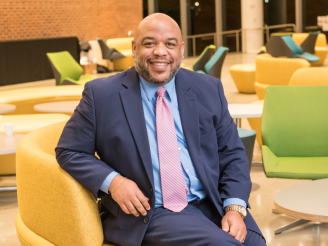Meet Victor Mullins, Stern’s New Senior Associate Dean for Diversity and Inclusion

You started in this role last December and were described as “not just hitting the ground running, but hitting the ground sprinting.” Why are people saying that and why was speed so important?
It might be because I launched both the diversity and inclusion website and newsletter on my first day at work. I’m super enthusiastic about my mission here at Stern, and it was important for me to seize the moment—on day one—to start creating change.
What does diversity and inclusion at Stern mean to you?
Let’s start with the big picture. It’s all about advancing our mission. When individual members of an organization thrive, the organization does, too. So the big picture of diversity and inclusion is pretty simple: create the conditions where talent, in all its forms, can thrive. The execution is a bit more challenging, but based on the many people I have met at Stern so far, we are ready for it!
Can you say more about the conditions that enable talent to thrive?
Individuals perform their very best when they feel they belong, are accountable for results, and have the least number of obstacles in front of them. Organizations thrive when there is a diversity of both perspectives and talent that is fully participating, actively listening, genuinely collaborating and creatively problem solving. Organizations that achieve this environment benefit from better decision making, and steady innovation and therefore advance the mission better, faster and with more creativity and energy. People in this sort of organization are generally happier, goals are achieved and talent is retained.
Without a conscious focus on diversity and inclusion (D&I), it’s easy for the opposite conditions to grow: picture an organization with a lot of “walls” that pop up for certain populations. Walls come in many forms and different populations experience different walls. A “wall” can present itself in big ways: being passed over for an interview, being ignored in a meeting, not being included in a decision. And in more subtle ways: not having access to a lactation room, being subtly judged for taking paternity leave, not being addressed with the right pronouns. The list is long. Organizations with a lot of “walls,” in effect, block its members from contributing at their greatest potential.
At Stern, we want to be an organization without walls. We want our employees to feel comfortable contributing. We want our faculty to optimize the range of voices in the classroom. We want our students to strengthen in all areas of EQ so they go on to contribute to the world at their highest potential and are sought after by employers.
How can we cultivate a “no wall” environment?
Let me start by saying what we are NOT doing. We are not going to take piecemeal approaches, especially those that do not align with the Stern mission; we are not going to do what’s comfortable and easy; we must learn how to sit in discomfort and become better when we do; we will not assume that our journey will be slow; and we will not leave people out.
Instead, we will take an “ecosystem approach.” What I mean by that is, we want this culture and mindset to grow in every pocket and process of the organization and in all populations, leaving no one behind. Our students, staff, and faculty will receive the necessary support as they advance the Stern mission, while advancing themselves. D&I actions, progress, outcomes, and impacts will be measured and rewarded.
An ecosystem approach ensures that all elements of the organization work together to first, fully envision its ideal future state; second, thoroughly assess where it is today; and third, plan a cohesive set of actions to help close the gap. When D&I is threaded through the entire ecosystem, change is not reliant solely on any one individuals’ awareness, motivation, or competencies to overcome both individual and systemic bias.
How will you know when you are succeeding?
When change becomes more automatic and feels less threatening. We will know we’ve made progress when D&I is no longer considered a stand alone “thing.” When it’s hard to point to “D&I activities” because they are embedded everywhere.
